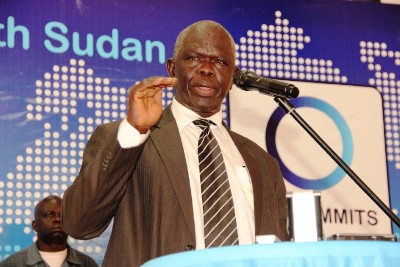S. Sudan annual budget underfunds development projects
August 25, 2014 (JUBA) – A large portion of South Sudan’s annual budget is spent on salaries and operational costs with very little on development projects, a local think tank said in a policy paper.

The national parliament, early this month, passed the SSP 11.279 billion, up by 8% SSP 0.876 billion from the 2013/14 budget, which was SSP 10.403 billion.
The new budget, extensively discussed by lawmakers, saw many cuts and realignments. Grant financing, for instance, declined by 55% from SSP 350 million in the 2013/2014 financial year to SSP192 million this financial year.
Garang believes such cuts and realignments could have made significant impacts as key infrastructure project, citing the 192km Juba-Nimule road which benefited from grant financing in the past budget.
Net oil revenues were forecasted to increase by 31% to SSP 8.9 billion from SSP 6.8 billion in the period covering 2013 and 2014 budget, depending on the improvement of the security situation.
A number of new loans in the new budget include US$10 million World Bank for South Sudan health repaid results; $21 million World Bank for safety net and skills development; $80 million for South Sudan-East Africa regional trade and Development Facilitation Program; and $150 million China Exim Bank loan for Juba Airport.
As of this July, South Sudan’s debt position reportedly stood at SSP 7.8 billion, including interest payments. But fears have emerged from economists that obligation for all arrears might exceed SSP 10.0 billion. This level of indebtedness translates to 89% of the 2014/2015 financial year budget.
“This means that if the debt was to be paid in full during FY2014/2015, for every $100 that South Sudan earns, $89 would pay for the loans, while only $11 is left to cater for the national priorities,” noted the policy paper.
However, debt repayment is scheduled over several years, ranging between three (commercial terms) to 40 (concessional terms) years, it further adds.
According to Garang, little has been devoted to development and peace while two-thirds of the budget is allocated to salaries and operation cost, leaving only 22% for the states and counties where the bulk of our population dwells.
“This is a mismatch between government vision of developing rural South Sudan and spending priorities. Such priorities should have been in peace and reconstruction, social and humanitarian, spending to preserve key economic sectors and solve the capacity gap,” the economist said.
“Moreover, too much emphasis is put on oil production picking up and if this does not materialise, the outcome will be played differently, maybe taking more oil advance sales or taking unconsolidated loans as has been the case and these have negative consequences on the overall development of the country,” he added.
The new budget is on one hand an instrument for mortgaging the future of South Sudan and on the other a vehicle for reinforcing its fragile state, Garang said.
“It is unfortunate that salaries make up about 40% of the overall budget. A regional comparison tells that South Sudan is spending more on salaries in contradiction to the mantra taking towns to people in the rural areas,” he added.
(ST)
